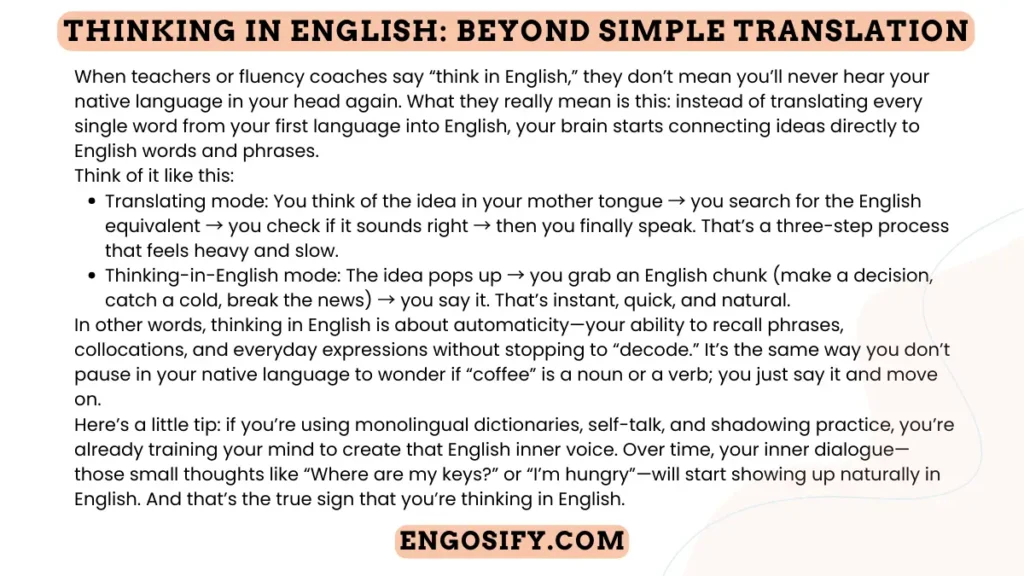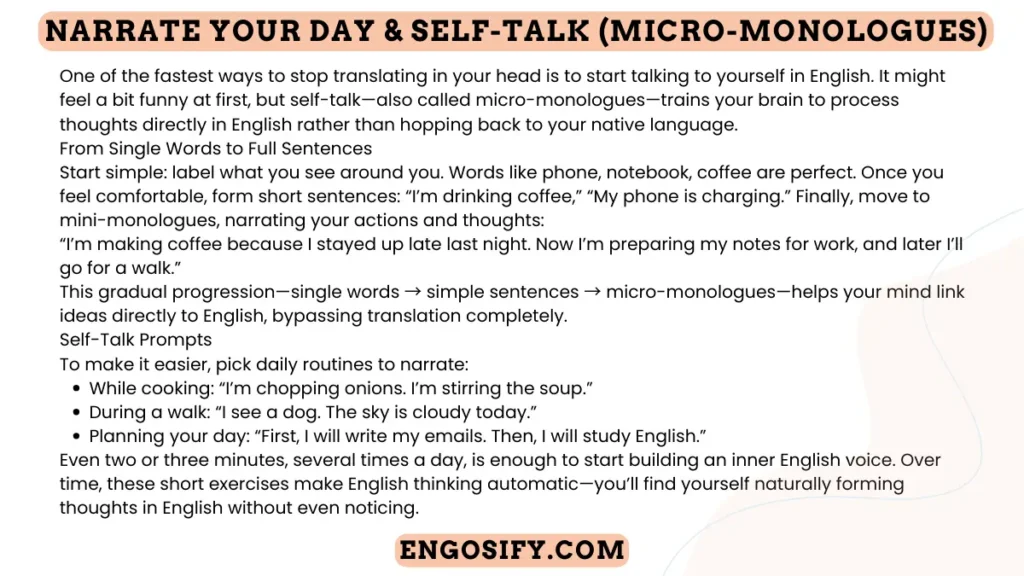Introduction: Why Thinking in English Beats Translating
Have you ever caught yourself pausing mid-sentence because your brain was busy translating from your first language into English? If so, you’re not alone. It’s one of the most common roadblocks for learners who can understand English but struggle to speak fluently. The truth is, when you depend on translation, your speech becomes slow, clunky, and sometimes even confusing.
But here’s the good news: you don’t have to stay stuck in that loop. With the right techniques, you can actually train your brain to think directly in English. That means creating an inner voice in English, building vocabulary through chunks and collocations, and making English your default mode of thought—without hopping back and forth to your native language.
In this article, we’ll break down seven practical tips to help you stop translating in your head and start thinking naturally in English. You’ll also find a simple 7-day micro-plan to put these strategies into action, plus answers to the most common questions learners ask. By the end, you’ll see that fluency isn’t about memorizing endless word lists—it’s about rewiring how you process and express ideas.
So, ready to flip the switch and think in English? Let’s dive in.
What Does It Mean to “Think in English”?
Thinking vs. Translating: Different Mental Processes
When you translate every word before speaking, your brain goes through two steps: first, it pulls the phrase in your native language, and then it scrambles to find the English equivalent. This back-and-forth slows you down, piles up cognitive load, and often results in awkward phrasing. Thinking directly in English, on the other hand, skips the middleman. It connects meaning to words in real time, so your speech flows naturally without those dreaded pauses.
Automaticity and Chunks Make Speech Effortless
Here’s the secret: fluent speakers don’t build sentences word by word—they use collocations and lexical chunks. For example, you don’t think “make + a + decision,” you just pull the ready-made phrase make a decision. These thought groups are like pre-packaged blocks your brain retrieves instantly, cutting translation out of the equation. If you’d like a deeper dive, Cambridge English offers a clear guide on what collocations are with examples.

Why Your Brain Keeps Translating (and How to Break It)
Cognitive Load & Working Memory Bottlenecks
Ever wondered why your mouth feels “stuck” when you’re trying to speak? That’s your working memory juggling too many tasks at once. When you translate, your brain has to hold the original sentence, search for English equivalents, check the grammar, and then produce the words—phew, no wonder it slows you down! This extra cognitive load drains your energy and leaves you sounding hesitant.
Instead, you want your brain to process English ideas directly. Think of it like taking the express train instead of switching lines three times. The fewer steps, the smoother and faster your communication.
Input First, Then Output: The Role of Comprehensible Input
Here’s another big reason translation lingers: you may not have had enough comprehensible input. In plain terms, if the English you read or hear is either too hard or too easy, your brain doesn’t build the right connections. According to Stephen Krashen’s i+1 principle, you should aim for material that’s just a notch above your current level. That way, you’re constantly stretching without breaking. If you’re curious about the research behind this, check out Krashen’s explanation of comprehensible input.
So, how do you break the habit? Flood yourself with English you can understand, pay attention to patterns, and slowly let your inner voice switch over. Instead of mentally flipping words from one language to another, your mind will begin absorbing meaning directly in English. And that’s when fluency starts to click.
Tip 1: Switch to Monolingual Input & Tools
Use Learner’s Dictionaries (Not Bilingual Ones)
Here’s the thing: when you lean on a bilingual dictionary, you keep feeding the translation habit. Every time you look up a word, you’re sending your brain back to your first language. A smarter approach is to use a learner’s dictionary that explains meanings directly in English, with simple definitions and example sentences. This way, you connect the idea straight to the English word—no middle step.
How to Do It Today
Flip your phone, apps, and even your GPS into English. Read easy, clear English texts like graded readers or blogs for learners. Every time you bump into a new word, look it up in an English-only dictionary and star it. Over time, your mind builds direct pathways to the meaning without that pesky detour through your native language.
Tip 2: Build Thought Groups with Collocations & Chunks
Why Chunks Kill Translation Latency
Fluent speakers rarely think word by word—they think in chunks. For instance, instead of piecing together “very + hungry,” you just grab the ready-made phrase starving. These collocations free up your brain, letting you speak without pausing to translate.
Practice Plan
Every day, learn five to ten new collocations. For example: make progress, heavy rain, break the news. Then, create at least three personal sentences for each one: “I made progress at work today,” “They broke the news gently.” The more you recycle them, the quicker they’ll pop into your head without translation. You can even check out Cambridge’s guide to collocations with clear examples to see how native speakers use them.
Tip 3: Narrate Your Day & Self-Talk (Micro-Monologues)
From Single Words → Simple Sentences → Short Monologues
Self-talk might sound a bit silly at first, but it’s one of the fastest ways to create an inner voice in English. Start small. Label what you see: “coffee,” “phone,” “notebook.” Then move to simple sentences: “I’m drinking coffee,” “My phone is charging.” Finally, stretch into short monologues: “I’m drinking coffee because I stayed up late last night, and now I’m preparing notes for work.”
Prompts
Try narrating as you cook, walk, or commute. Ask yourself: What am I doing? What will I do next? How do I feel right now? Two or three minutes of this, several times a day, will gradually replace translation with natural English thought. Over time, you’ll find your inner dialogue switching languages almost without effort.

Tip 4: Shadow Native Speech to Sync Sounds + Meaning
What Shadowing Is and Why It Works
Shadowing is like echoing: you listen to a native speaker and repeat immediately, almost overlapping their words. This technique locks in rhythm, stress, and intonation patterns, while training your brain to link sound and meaning directly. Instead of translating, you copy the flow of English as it comes, which builds fluency lightning-fast.
How to Shadow
Start with clear, slow audio—podcasts for learners, YouTube explainers, or audiobooks with transcripts. Read along while echoing every phrase, then try it again without the text. The magic happens when your mouth keeps up with your ears. If you’d like a deeper dive into the background of this technique, here’s a useful overview of speech shadowing in psycholinguistics.
Tip 5: Name Objects & Actions Around You (Direct Mapping)
Rapid Labelling Builds Direct L2 Links
When you name objects in English—door, spoon, window, shoes—you create a direct connection between the item and the English word. Same goes for actions: open, stir, write, stretch. No detour through your native tongue.
Routine
Make it a daily mini-game. Pick ten objects and ten actions to label. Point, say the word aloud, and repeat at night without looking. The goal is speed: the faster you name it, the less chance your brain has to sneak in translation.
Tip 6: Routine Micro-Writing & Journaling in English
Low-Pressure Output Consolidates Your Inner Voice
Writing is thinking on paper. When you journal in English, you train your inner voice to process ideas in the target language. The best part? It’s private, low-pressure, and flexible—you don’t need to impress anyone.
Template
Use a simple three-line structure:
- Today I…
- I’m grateful for…
- Tomorrow I will…
Spending just five minutes each evening writing these lines solidifies your vocabulary, sentence frames, and confidence. Before long, you’ll notice your thoughts flowing in English even when you’re not writing.
Tip 7: Reflection & Error-Noticing Without Switching to L1
Review in English, Not Your First Language
After a conversation or journaling session, resist the urge to analyze in your mother tongue. Instead, think: What worked? What was missing? Do it all in English. This way, you reinforce the habit of problem-solving directly in the language.
Upgrade Lines
Whenever you catch yourself saying something literal—like “make a photo” instead of “take a photo”—create an upgrade line. Write the correct version in English only, repeat it a few times, and try it again in your next self-talk. Bit by bit, these upgraded patterns replace translation with authentic English.
Your 7-Day Micro-Plan (10–15 Minutes a Day)
The best way to stop translating in your head isn’t by cramming—it’s by small, daily habits. Here’s a seven-day routine you can cycle through week after week. Each task takes just a few minutes, but the results add up fast.
Day 1: Switch & Label
- Change at least three apps or device settings into English.
- Label ten everyday objects in English (mirror, sink, blanket).
Day 2: Learn Collocations
- Pick eight collocations (do homework, heavy traffic, catch a cold).
- Write eight personal sentences: “I did my homework early,” “We got stuck in heavy traffic.”
Day 3: Shadow a Short Clip
- Choose a two-minute video with subtitles.
- Shadow it once with text, then again without.
Day 4: Self-Talk Mini-Monologues
- Do two 90-second “talks” about your day: what you did, what you’re doing, what you’ll do.
Day 5: Journal & Dictionary Work
- Write a short 100-word entry: Today I learned…
- Look up five new words in a monolingual learner’s dictionary.
Day 6: Label Actions
- Pick ten verbs (stir, fold, unlock, swipe).
- Act them out while saying the word aloud.
Day 7: Record & Reflect
- Record yourself speaking for two minutes.
- Listen back and create five upgrade lines (better ways of saying something).
How to Measure Progress (and Stay Consistent)
Signals You’re Thinking in English
Notice these signs:
- You pause less often and sentences feel smoother.
- Words come faster without the “translation delay.”
- You start dreaming or self-talking in English without forcing it.
Tiny Habit Loop
Consistency beats intensity. Pair each activity with a trigger: after breakfast → label objects, before bed → write three journal lines. Keep it short (two minutes minimum) so you never feel overwhelmed. Track your streak on paper or in an app.
When you combine regular input with daily output, your brain gradually rewires itself. English shifts from a subject you study to a tool you think with.
Avoid These Pitfalls
Even with the best intentions, many learners slip into habits that keep them stuck translating in their heads. Here are three traps to watch out for—and how to fix them.
Over-Translating Every New Word
If you grab your bilingual dictionary for every unknown word, you’re strengthening the very habit you want to break. Instead, use context clues and example sentences from a monolingual source. This way, the meaning attaches directly to the English word.
Consuming Input That’s Too Hard or Too Easy
If material feels like rocket science, you’ll burn out; if it’s too easy, you’ll get bored. Aim for the sweet spot—just above your current level, what linguist Stephen Krashen calls i+1. You can explore the research in his paper on comprehensible input.
Shadowing Too Fast
If you start shadowing high-speed podcasts or movies, you’ll stumble and give up. Begin with slower, clear speech, then gradually increase the pace. Think of it like learning to run: you don’t sprint on day one—you jog, then build speed.

FAQs
How do I stop translating in my head when speaking English?
Use chunks and collocations, practise self-talk, and try shadowing. These methods link words directly to ideas instead of your native language.
How long until I think in English?
It depends on your routine. Some learners notice a shift in a few weeks if they practise daily. For others, it takes months. The key is steady, consistent input and output.
Is translating always bad?
Not necessarily. In the very beginning, translation helps you grasp meaning. But if you rely on it too long, it slows your fluency. Aim to reduce it step by step.
Does shadowing really help fluency?
Absolutely! Shadowing improves intonation, rhythm, and automaticity. By echoing native speech, you bypass translation and train your brain to think in English. You can learn more from the background of speech shadowing.
Should I use bilingual dictionaries?
Try not to. Bilingual dictionaries keep your brain in translation mode. Instead, go for a learner’s monolingual dictionary, which explains meanings in clear English with examples.
What level do I need to start thinking in English?
Any level works! Even beginners can start with single words (apple, walk, happy). Over time, move to phrases, then full sentences. The important part is to begin.
Conclusion
Learning how to think in English isn’t about memorizing endless grammar rules or cramming vocabulary lists. It’s about reshaping the way your brain processes language. By switching to monolingual input, practicing with collocations and chunks, talking to yourself in English, shadowing native speakers, naming objects and actions, journaling daily, and reflecting with upgrade lines, you’ll gradually cut out the translation step that slows you down.
Start small with the 7-day micro-plan—just a few minutes a day. Over time, you’ll notice smoother speech, faster recall, and even those quiet moments when your inner voice naturally switches to English. That’s when you’ll know: you’re not just studying English anymore—you’re living it in your mind.
So, the next time you catch yourself pausing to translate, remember—you’ve got the tools to flip the switch. Keep practising, stay consistent, and let your thoughts flow directly in English.

